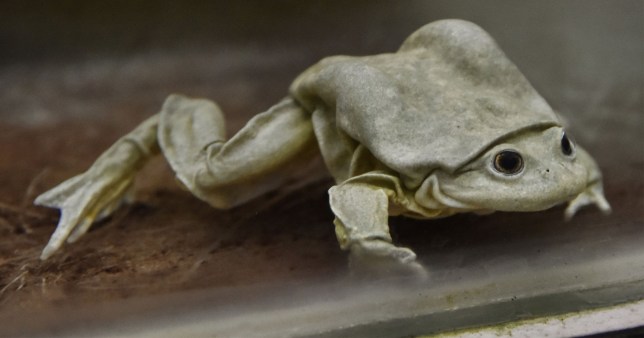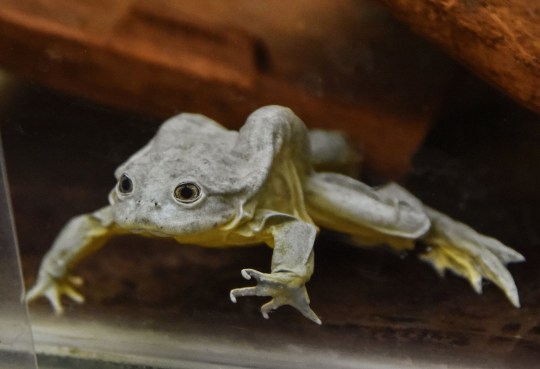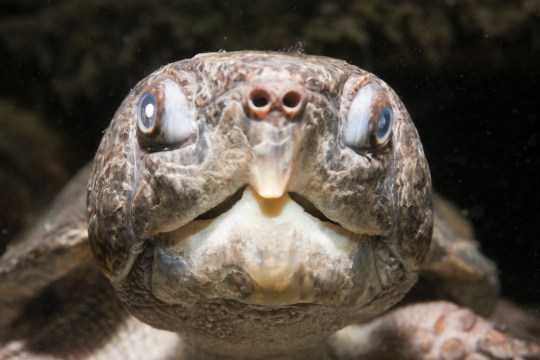It’s no secret that the animal world is full of bizarre and unbelievable creatures – just this week, ‘spaghetti monsters’ that look like a disembodied eyeballs began washing up on Texas beaches.
Closer to home however, Londoners can now catch a glimpse of another fabulously weird species, the scrotum frog.
Well, obviously that’s a nickname, on account of being super wrinkly – but being officially known as the Lake Titicaca frog can be just as hilarious, with the right attitude.
And they’re not just funny, they’re also massive.
‘Lake Titicaca frogs are a bizarre looking frog,’ said Dr Ben Tapley, curator of reptiles and amphibians at London Zoo, where visitors can get up close to them. ‘With bulbous eyes and baggy grey skin, they’ve earned themselves the nickname of “scrotum frogs”. These are large frogs that are known to weigh up to 1kg.’
Less funny however is the fact they are endangered, mainly due to a deadly fungus that has already wiped a number of species off the planet, and being eaten in smoothies in known as ‘frog juice’, believed to be an aphrodisiac in their native Peru.
‘Sadly, these frogs are threatened by the spread of chytrid fungus – a fungus that causes a disease that is decimating amphibian populations all over the world,’ said Dr Tapley. ‘The Zoological Society of London is leading the fight against this disease, in the hope we can protect these unique frogs, and so many others.’
Also hilariously named but at risk of extinction is the big-headed turtle, which visitors to the zoo can also catch a glimpse of.
Dr Tapley said: ‘The big-headed turtle, like its name suggests, has a gigantic muscular head – it’s so large that it cannot retract back into its shell like most other turtle species.
‘Big-headed turtles are an EDGE species, which means they’re considered a global priority for conservation due to being evolutionary distinct and globally endangered. There are no other species like them, but they do need our help in the wild as they are threatened by the trade for meat.
‘With our partners, the Asian Turtle Program, we have rescued 360 big-headed turtles from the illegal wildlife trade in Vietnam and released these into protected areas. The animals here at London Zoo are the offspring of turtles who were rescued from the illegal wildlife trade in Canada.’
Across the globe, amphibians are the most threatened class of vertebrates – animals like mammals, birds, fish and reptiles. According to a recent study, 40.7% of all species are at risk.
London Zoo, like others across the world, are working hard to protect those we have left, including breeding rare species like the mountain chicken frog. Native to the Caribbean islands of Montserrat and Dominica, their numbers are also plummeting due to the killer chytridiomycosis.
The fungus eats away at the animals’ skin which, because it helps them breath and stay hydrated, can quickly kill them.
However, visitors to the zoo’s new Secret Life Of Reptiles And Amphibians experience can get a glimpse of the fantastic frogs up close, alongside other special animals including giant salamanders, the Mangshan pit viper and Philippine crocodiles.
Jawsome.
MORE : Life could exist on Venus after all – despite its toxic clouds
MORE : It’s chocolate time – here’s why it could be good for you
MORE : Godzilla vs King Kong – here’s who would really win
Get your need-to-know
latest news, feel-good stories, analysis and more
This site is protected by reCAPTCHA and the Google Privacy Policy and Terms of Service apply.










